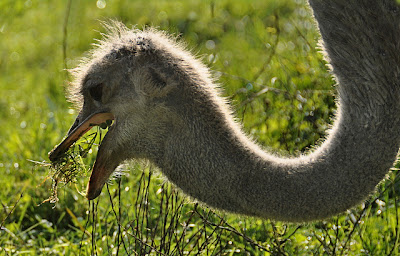Although native only to parts of Africa, the ostrich is still one of the world’s best known birds. This is partly due to its bizarre appearance, characterised by a round dumpy body, spindly legs and a long neck that extends upwards to a small head.
 |
| Ostrich eggs and next |
The ostrich was once famed for its feathers, which were used as hat plumes. Now the ostrich is farmed for its meat, its skin and kept in zoos as a tourist attraction. It has also been trained to scare birds away from crops, to round up sheep, as well as to be ridden in ostrich races.
The ostrich was first introduced into Australia in the 1860’s. As in South Africa, many of those farmed managed to escape and began to breed in the wild.
What do ostriches eat?
 |
| THE OSTRICH - Struthio camelus |
Lowering its long neck, it accurately pecks up the food and then stores it in its gullet, before finally passing it down the gut in a large ball. This passage can be clearly seen, as it stretches the highly elastic skin of the ostrich’s neck.
Like many other birds, the ostrich also swallows grit and small stones with its food. These grind up the tough plant material which it eats, in the muscular gizzard – the ostrich’s second stomach – and so helps with its digestion.
While grazing, the ostrich regularly raises its long neck to scan the horizon for any signs of danger. It has acute vision and its eyes are the largest of any land animal in relation to the size of its head.
Ostrich breeding
 |
| Ostrich with family |
Now it gets a bit complicated. Up to 18, although more usually 2 to 5 ‘minor hens’ then lay their eggs in the same nest. The minor hens leave the male and major hen to guard and incubate the clutch.
However, as night falls, the male takes over the task of incubation.
The ostrich can incubate a large number of eggs, and 20 is not unusual! If there are more eggs than can be incubated, the major hen will roll some of the minor hens eggs to the edge of the nest where they will fail to hatch. Soon after hatching, the brood joins up with broods from other nests, with one or two adults guarding the whole lot. Only about 15% of chicks will live beyond a year which is when they reach their adult height. The remainder mainly fall prey to hyenas and jackals.
For more information click onto:
EMU FACTS
OSTRICH FACTS
THE OSTRICH
WHAT DO EMU'S EAT?
WHAT IS AN EMU?
WHAT IS THE WORLD'S HEAVIEST FLYING BIRD?







No comments:
Post a Comment